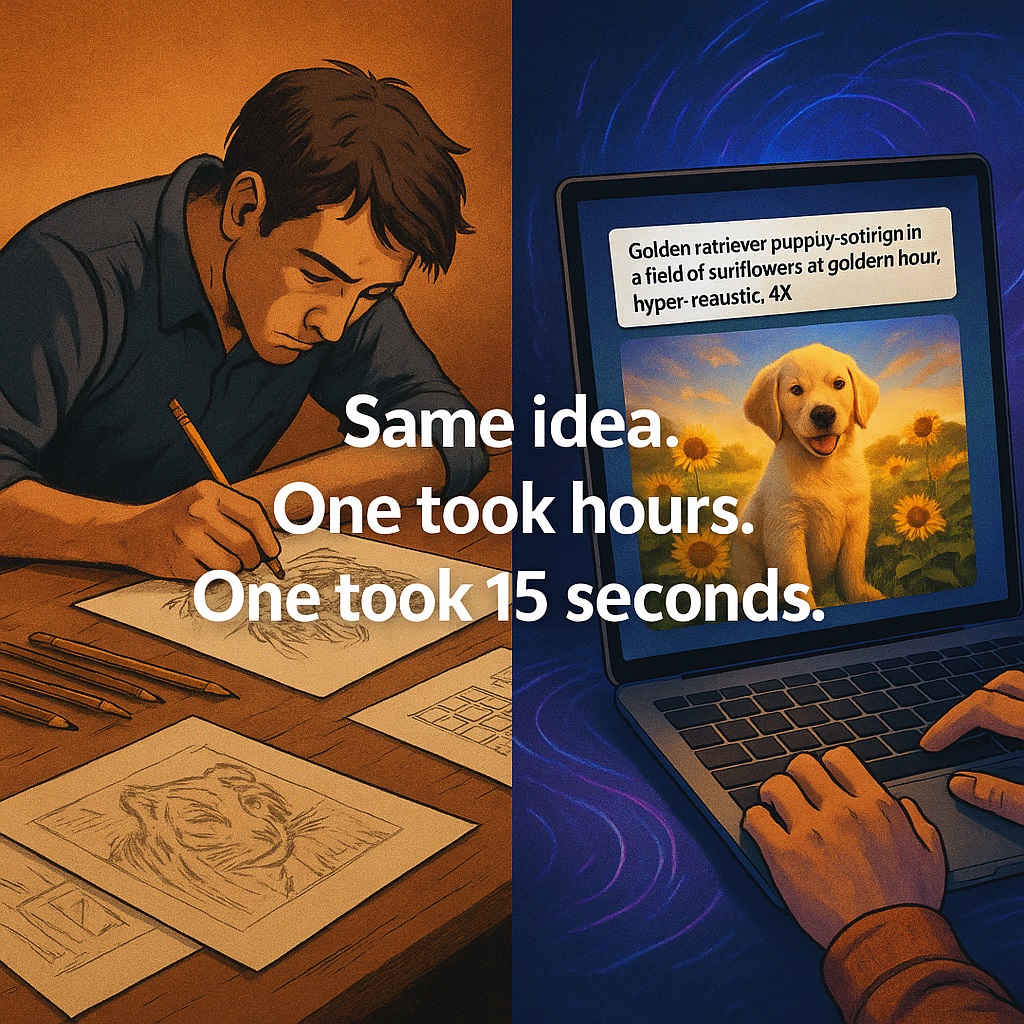Silence. A blank canvas. The cursor blinks, waiting. But there’s no time to wait. Deadlines move. Clients breathe down necks. The demand for content never slows.
Then prompt, generate, done. Stunning visuals in seconds. That’s the power of the AI image generator.
You’re not just speeding up. You’re leaping ahead.
Why everyone suddenly cares about AI image generation
Because it works. Because it’s fast. Because the results look incredible.
What began as an experimental plaything is now a force in commercial design. Midjourney, DALL·E, Adobe Firefly, and Stable Diffusion have shattered the myth that only humans create art.
These tools don’t guess. They analyze. They predict. They build from billions of data points and spit out a result tailored to your command.
From startups to global brands, creative teams now rely on AI image generators to stay competitive.
Use cases that matter right now
- Marketers use it to generate ad concepts and test them before spending a dime.
- Social media managers create themed carousels, weekly graphics, and memes in bulk.
- UX designers mock up interfaces and illustrations on the fly.
- Product teams visualize concepts before they even reach prototyping.
- Educators build custom, copyright-safe visuals for courses.
The value isn’t just in speed. It’s in scale. What once took hours now takes moments.
The death of the stock photo
Let’s be honest: everyone has seen that same handshake photo a thousand times.
Stock images are sterile, repetitive, and expensive. AI image generators offer a tailored alternative. Unique. On-brand. Rights-safe (if you pick the right platform).
Need a retro-style astronaut eating ramen in Tokyo? Done. Want it as a watercolor? Also done.
The only limit? How well you prompt.
The prompt is the new brush
Prompts are the interface between human imagination and machine output. Lazy prompts produce lazy images. Specific prompts open doors to magic.
Example:
- Bad: “person running”
- Great: “young woman jogging at sunrise on a foggy mountain trail, cinematic lighting, high detail”
This is creative direction in text form.
Master prompting, and you master the tool. No Photoshop degree required.
But won’t this kill creative jobs?
No. But it will kill boring creative jobs.
Low-level, repetitive tasks? Automated. Good riddance.
But strategy, taste, vision? Still human.
AI image generators are partners. You steer. They execute.
The creatives who thrive will be those who learn to guide, refine, and combine machine output with human storytelling. This isn’t the end of art. It’s a reinvention of craft.
Top platforms you should be using
1. Midjourney
Famous for dreamy, detailed outputs. Perfect for brand work and experimental projects.
2. DALL·E (OpenAI)
Strong integration with ChatGPT. Flexible, fast, and surprisingly accurate.
3. Adobe Firefly
Trained on licensed data, making it safe for commercial work. Plays well with Photoshop.
4. Stable Diffusion
Open-source, developer-friendly, and endlessly customizable.
5. Canva AI
Great for beginners. Fast, accessible, and social media ready.
Each platform has a style. Test them. Blend them. Build your stack.
How brands are already winning
- Heinz generated a campaign using AI to answer: “What does ketchup look like to AI?”—and the answer looked exactly like Heinz.
- Coca-Cola launched Create Real Magic, inviting fans to generate branded art with AI.
- Warner Bros. used Midjourney-style visuals for concept pitches and trailer mood boards.
This isn’t niche anymore. It’s mainstream. It’s monetized.
Limitations to keep in mind
Not everything’s perfect.
- Hands can be weird. (Still a work in progress.)
- Factual accuracy is hit-or-miss.
- Copyright laws? Still evolving.
Don’t treat AI output as gospel. Treat it as draft one.
Use judgment. Combine AI with verification, editing, and ethical filters.
Practical steps to get started today
- Pick one tool and sign up. Don’t wait for the “perfect” platform.
- Create 10 images using the same prompt, changing styles each time.
- Learn to refine. Tweak. Iterate.
- Compare outputs to your current design assets. Where does it win? Where does it fail?
- Share results. Ask for feedback. Improve.
AI doesn’t replace creativity. It reveals it faster.
The real flex is hybrid creativity
Imagine this:
- Generate a concept in DALL·E.
- Refine color grading in Photoshop.
- Add text overlays in Canva.
- Publish to LinkedIn, Medium, and your brand site.
All in under an hour.
That’s what AI image generation unlocks. Creative sprints at marathon volume.
Final warning: ignore this, and you fall behind
Designers who don’t adapt will watch clients vanish. Agencies that scoff at AI will lose pitches to faster, cheaper, smarter rivals.
Adaptation isn’t optional. It’s survival.
Get curious. Get messy. Generate.



